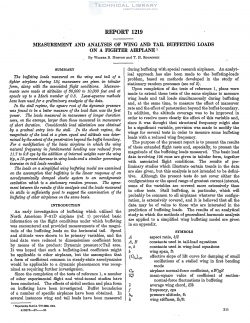naca-report-1219
- Version
- 191 Downloads
- 3.06 MB File Size
- 1 File Count
- November 2, 2016 Create Date
- November 2, 2016 Last Updated
National Advisory Committee for Aeronautics, Report - Measurement and Analysis of Wing and Tail Buffeting Loads on a Fighter Airplane

The buffeting loads measured on the wing and tail of a
fighter airplane during 194 maneuvers are given in tabular
form, along with the associated flight conditions Measure-
ments were made at altitudes of 30,000 to 10,000 feet and at
speeds up to a Mach number of 0.8. Least—squares methods
have been used for a preliminary analysis of the data.
In the stall regime, the square root of the dynamic pressure
was found to be a better measure of the load than was the first
power. The loads measured in maneuvers of longer duration
were, on the average, larger than those measured in maneuvers
of short duration. Considerable load alleviation was obtained
by a gradual entry into the stall. In the shock regime, the
magnitude of the load at a given speed and altitude was deter—
mined by the extent of the penetration beyond the bufiet boundary.
For a modification of the basic airplane in which the wing
natural frequency in fundamental bending was reduced from
11.7 to 9.3 cps by the addition of internal weights near the wing
tip, a 1 5-percent decrease in wing loads and a similar percentage
increase in tail loads resulted.
The loads on a simplified wing bufi'eting model are examined
on the assumption that bufl'eting is the linear response of an
aerodynamically damped elastic system to an aerodynamic
excitation which is a stationary random process. The agree-
ment between the results of this analysis and the loads measured
in stalls is suficiently good to suggest the examination of the
bufl’eting of other airplanes on the same basis.
An early investigation of bufl’eting which utilized the
North American F—51D airplane (ref. 1) provided basic
information on the flight conditibns under which buffeting
was encountered and provided measurements of the magni—
tude of the buffeting loads on the horizontal tail. Speed
and altitude were shown to be primary variables, and the
load data were reduced to dimensionless coefficient form
by means of the product: Dynamic pressureXTail area.
It was hoped that such a bufleting—load coeflicient might
be applicable to other airplanes, but the assumption that
a form of coefficient common in steady-state aerodynamics
would be applicable to a dynamic phenomenon was recog~
nized as requiring further investigation.
| File | Action |
|---|---|
| naca-report-1219 Measurement and Analysis of Wing and Tail Buffeting Loads on a Fighter Airplane.pdf | Download |
Comment On This Post